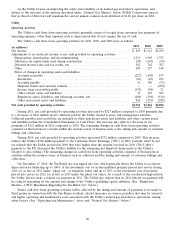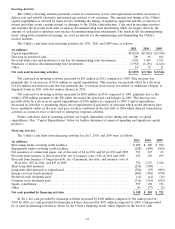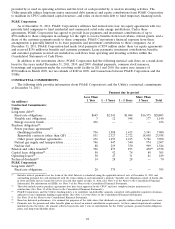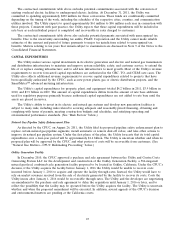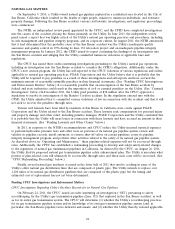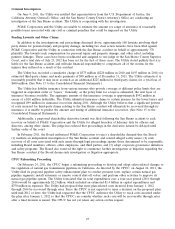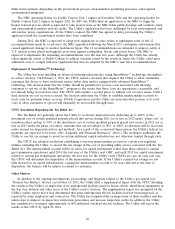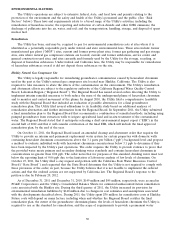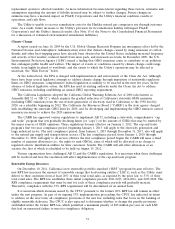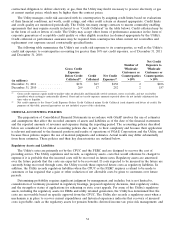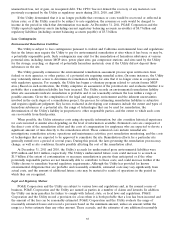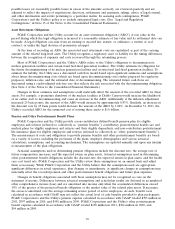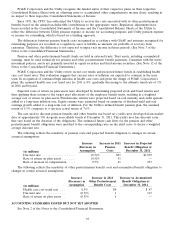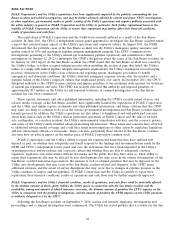PG&E 2011 Annual Report Download - page 34
Download and view the complete annual report
Please find page 34 of the 2011 PG&E annual report below. You can navigate through the pages in the report by either clicking on the pages listed below, or by using the keyword search tool below to find specific information within the annual report.ENVIRONMENTAL MATTERS
The Utility’s operations are subject to extensive federal, state, and local laws and permits relating to the
protection of the environment and the safety and health of the Utility’s personnel and the public. (See ‘‘Risk
Factors’’ below.) These laws and requirements relate to a broad range of the Utility’s activities, including the
remediation of hazardous wastes; the reporting and reduction of carbon dioxide and other GHG emissions; the
discharge of pollutants into the air, water, and soil; and the transportation, handling, storage, and disposal of spent
nuclear fuel.
Remediation
The Utility has been, and may be, required to pay for environmental remediation costs at sites where it is
identified as a potentially responsible party under federal and state environmental laws. These sites include former
manufactured gas plant (‘‘MGP’’) sites, current and former power plant sites, former gas gathering and gas storage
sites, sites where natural gas compressor stations are located, current and former substations, service center and
general construction yard sites, and sites currently and formerly used by the Utility for the storage, recycling, or
disposal of hazardous substances. Under federal and California laws, the Utility may be responsible for remediation
of hazardous substances even if it did not deposit those substances on the site.
Hinkley Natural Gas Compressor Site
The Utility is legally responsible for remediating groundwater contamination caused by hexavalent chromium
used in the past at the Utility’s natural gas compressor site located near Hinkley, California. The Utility is also
required to take measures to abate the effects of the contamination on the environment. The Utility’s remediation
and abatement efforts are subject to the regulatory authority of the California Regional Water Quality Control
Board, Lahontan Region (‘‘Regional Board’’). The Regional Board has issued several orders directing the Utility to
implement interim remedial measures to both reduce the mass of the underground plume of hexavalent chromium
and to monitor and control movement of the plume. In August 2010, the Utility filed a comprehensive feasibility
study with the Regional Board that included an evaluation of possible alternatives for a final groundwater
remediation plan. The Utility filed several addendums to its feasibility study based on additional analyses of
remediation alternatives and further information from the Regional Board. In September 2011, the Utility submitted
a final remediation plan to the Regional Board that recommends a combination of remedial methods, including using
pumped groundwater from extraction wells to irrigate agricultural land and in-situ treatment of the contaminated
water. The Regional Board stated that it anticipates releasing a draft environmental impact report (‘‘EIR’’) in the
second half of 2012 and that it will consider certification of the final EIR, which will include the final approved
remediation plan, by the end of the year.
On October 11, 2011, the Regional Board issued an amended cleanup and abatement order that requires the
Utility to provide an interim and permanent replacement water system for certain properties with domestic wells
containing hexavalent chromium concentrations above the 3.1 parts per billion (‘‘ppb’’) background level and propose
a method to evaluate individual wells with hexavalent chromium concentrations below 3.1 ppb to determine if they
have been impacted by the Utility’s past operations. The order requires the Utility to provide evidence to prove that
the provided water meets primary and secondary drinking water standards and contains hexavalent chromium in
concentrations no greater than 0.02 ppb. The order notes that for purposes of this standard, drinking water must test
below the reporting limit of 0.06 ppb due to the limitation of laboratory analysis of low levels of chromium. On
October 25, 2011, the Utility filed a stay request and petition with the California State Water Resources Control
Board (‘‘State Board’’) and requested that the State Board determine that the Utility is not required to comply with
these provisions of the order, in part, because the Utility believes that it is not feasible to implement the ordered
actions and that the ordered actions are not supported by California law. The Regional Board’s response to the
petition is due by February 20, 2012.
As of December 31, 2011 and December 31, 2010, $149 million and $45 million, respectively, were accrued in
PG&E Corporation’s and the Utility’s Consolidated Balance Sheets for estimated undiscounted future remediation
costs associated with the Hinkley site. During the third quarter of 2011, the Utility increased its provision for
environmental remediation liabilities by $140 million due to changes in cost estimates and assumptions associated
with the developments described above. During 2011, the Utility spent $36 million for remediation costs at Hinkley.
Future costs will depend on many factors, including when and whether the Regional Board certifies the final
remediation plan, the extent of the groundwater chromium plume, the levels of hexavalent chromium the Utility is
required to use as the standard for remediation, and the scope of requirements to provide a permanent water
30


